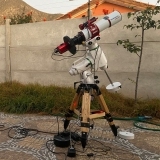INDI Library v2.0.7 is Released (01 Apr 2024)
Bi-monthly release with minor bug fixes and improvements
Help - Unable to connect Zwo ASI 1600MM
Replied by Giles on topic Help - New to Astoberry
All in all it looks like there were quite a few updates, and you do have something working.
For the rpi-eeprom stuff, that is done, and it will only need to kick in should there be a new update appear on the EEPROM git site.
If you have the ethernet connected to the BT Hub, and this is good for you on a permanent basis I would leave it at that, the Ethernet cable is always going to be faster and more reliable than a Wireless connection.
In order to keep your system up to date, you should just have to:
sudo apt update
sudo apt upgrade
There is also "sudo apt full-upgrade" and "sudo apt dist-upgrade" not sure exactly what the difference is, but sometimes updates appear that only get installed when you run those.
It only needs to be relatively up to date, sometimes too many changes and you get yourself in a situation where you are updating even when things are working, and then something breaks...
If you don't want to permanently use the wired connection (despite it almost certainly being faster and more reliable), then at least you are now in a position to tinker around and try to get the Wireless side up and running, but having the wired side to fall back on will hopefully mean that you don't need to re-flash your SD card if you take a wrong turn.
Good luck.
Please Log in or Create an account to join the conversation.
- Radek Kaczorek
-

- Offline
- Moderator
-

- Posts: 983
- Thank you received: 375
Replied by Radek Kaczorek on topic Help - New to Astoberry
Astroberry Hotspot is automatically activated ONLY when no other connections are detected. It is a feature not a bug. This is a fallback connection in case you loose primary wire/wireless connection or you are in the field. This is also default wifi connection at the first boot.
As soon as you add another wifi connection and reboot, Astroberry Hotspot is disabled automatically. And this is the point where you thought something's wrong with your system. However, this means that everything is all right! No Astroberry Hotspot means the system is successfully connected to your home wifi network. This also means that you can access it by connecting your PC to your home network and point your browser to astroberry.local or VNC client to the astroberry.local :5900
Please Log in or Create an account to join the conversation.
- Douglas Mason
-
 Topic Author
Topic Author
- Offline
- Senior Member
-

- Posts: 46
- Thank you received: 1
Replied by Douglas Mason on topic Help - New to Astoberry
Hi,
Thanks for this information.
So there is basically a hierarchy, wired followed by wireless and if all else fails or if were out in the field then there is the good old hotspot to fall back on.
The problem I was having as a newbie was the fact that I could see the hotspot showing up in my networks when I first booted up my RPI and could click on it then connect to Astroberry via 10.42.0.1. Once in astroberry I set-up the wifi and it asked me to reboot which I did. When the reboot happened i could no longer see the hotspot in list of networks (i now know this to be correct as the RPI was picking up wireless network). However I did open IE and pointed the web to 10.42.0.1 but it did not open Astroberry and this is why I thought it had crashed etc.
I take it you see nothing but your own wireless details in networks when it connect to the wifi.
If using wifi do I need to point my internet to raspberrypi.local instead of 10.42.0.1.
The other thing I've noticed whilst messing with the wifi connection is the fact that each time I go into the wireless settings it is always asking for country code, is this correct.
Thanks
Doug
Please Log in or Create an account to join the conversation.
- Wouter van Reeven
-

- Offline
- Supernova Explorer
-

- Posts: 1957
- Thank you received: 420
Replied by Wouter van Reeven on topic Help - New to Astoberry
HTH, Wouter
Please Log in or Create an account to join the conversation.
Replied by ouioui01 on topic Help - New to Astoberry
Or you could use astroberry.local (if you did not change the hostname)
Clear skies
Please Log in or Create an account to join the conversation.
- Wouter van Reeven
-

- Offline
- Supernova Explorer
-

- Posts: 1957
- Thank you received: 420
Replied by Wouter van Reeven on topic Help - New to Astoberry
It is worth a try but I think it depends on the router if that works or not. Not all routers adopt the host name of the machines they provide DHCP addresses to. So if that doesn't work you'll need to go to the admin console of your router and look up the IP address assigned.
Wouter
Please Log in or Create an account to join the conversation.
Replied by Giles on topic Help - New to Astoberry
Please Log in or Create an account to join the conversation.
- Douglas Mason
-
 Topic Author
Topic Author
- Offline
- Senior Member
-

- Posts: 46
- Thank you received: 1
Replied by Douglas Mason on topic Help - New to Astoberry
Hi,
Thanks very much for the reply, I forgot I've got an app on my phone from BT that gives me the IP addresses so its easy for me to see the RPI.
I think I have enough info to get going and now I need to learn Kstars & Ekos.
You have a similar set up to me, I have the ASI 1600 MM Cool, HEQ5 Pro (Belt Drive), Skywatcher ED80 and a Altai Astro GP cam for guiding. I bought the ASI 1600MM cool 2nd hand and have not really used it in anger, how do you find your camera. I see you have the Esprit, this is what I would like next.
Thanks again
Doug
Please Log in or Create an account to join the conversation.
Replied by Giles on topic Help - New to Astoberry
The ASI1600MM is a great CMOS camera. I don't think you will be disappointed.
The Esprit 120 Pro is also on my wish-list - once we are over the current issues worldwide, and I can look at the bank balance with confidence, it's my next purchase (along with the necessary accessories).
Please Log in or Create an account to join the conversation.
- Douglas Mason
-
 Topic Author
Topic Author
- Offline
- Senior Member
-

- Posts: 46
- Thank you received: 1
Replied by Douglas Mason on topic Help - New to Astoberry
I would just like to thank everyone for their help to-date on this one.
I am now starting to understand RPI & Astroberry. I'll set everything up and will proceed to attach one piece of equipment to the software at a time so I can ensure it is working properly before moving onto the next one.
Thanks again
Doug
Please Log in or Create an account to join the conversation.
- Douglas Mason
-
 Topic Author
Topic Author
- Offline
- Senior Member
-

- Posts: 46
- Thank you received: 1
Replied by Douglas Mason on topic Help - New to Astoberry
Thanks,
I've been using a modified DSLR for many years and took a punt on the ASI 1600MM, Starlight express filter wheel and filters. I think the camera itself will be a big learning curve as I'm use to doing 5 - 10 min subs when at a dark site and I understand you can use much shorter subs with this camera.
Doug
Please Log in or Create an account to join the conversation.
- Douglas Mason
-
 Topic Author
Topic Author
- Offline
- Senior Member
-

- Posts: 46
- Thank you received: 1
Replied by Douglas Mason on topic Help - New to Astoberry
Just a quick question, when coming out of Astroberry do I use 'Shutdown' or 'Disconnect' or doesn't it matter.
Thanks
Doug
Please Log in or Create an account to join the conversation.
